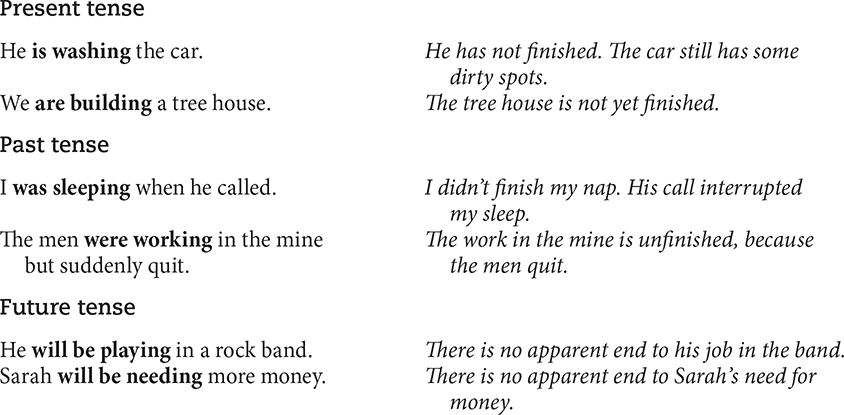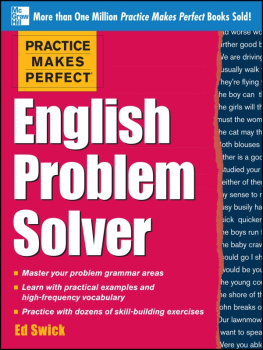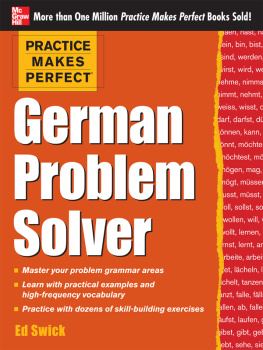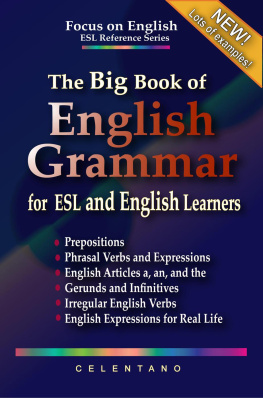Contents
Guide
Page List


Copyright 2018 by McGraw-Hill Education. All rights reserved. Except as permitted under the United States Copyright Act of 1976, no part of this publication may be reproduced or distributed in any form or by any means, or stored in a data base or retrieval system, without the prior written permission of the publisher. ISBN: 978-1-26-001924-7
MHID: 1-26-001924-1 The material in this eBook also appears in the print version of this title: ISBN: 978-1-26-001923-0
MHID: 1-26-001923-3. eBook conversion by codeMantraVersion 1.0 All trademarks are trademarks of their respective owners. Rather than put a trademark symbol after every occurrence of a trademarked name, we use names in an editorial fashion only, and to the benefit of the trademark owner, with no intention of infringement of the trademark.
Where such designations appear in this book, they have been printed with initial caps. McGraw-Hill Education eBooks are available at special quantity discounts to use as premiums and sales promotions or for use in corporate training programs. To contact a representative, please visit the Contact Us page at www.mhprofessional.com. Trademarks: McGraw-Hill Education, the McGraw-Hill Education Publishing logo, Practice Makes Perfect, and related trade dress are trademarks or registered trademarks of McGraw-Hill Education and/or its affiliates in the United States and other countries and may not be used without written permission. All other trademarks are the property of their respective owners. McGraw-Hill Education is not associated with any product or vendor mentioned in this book.
TERMS OF USE This is a copyrighted work and McGraw-Hill Education and its licensors reserve all rights in and to the work. Use of this work is subject to these terms. Except as permitted under the Copyright Act of 1976 and the right to store and retrieve one copy of the work, you may not decompile, disassemble, reverse engineer, reproduce, modify, create derivative works based upon, transmit, distribute, disseminate, sell, publish or sublicense the work or any part of it without McGraw-Hill Educations prior consent. You may use the work for your own noncommercial and personal use; any other use of the work is strictly prohibited. Your right to use the work may be terminated if you fail to comply with these terms. THE WORK IS PROVIDED AS IS.
McGRAW-HILL EDUCATION AND ITS LICENSORS MAKE NO GUARANTEES OR WARRANTIES AS TO THE ACCURACY, ADEQUACY OR COMPLETENESS OF OR RESULTS TO BE OBTAINED FROM USING THE WORK, INCLUDING ANY INFORMATION THAT CAN BE ACCESSED THROUGH THE WORK VIA HYPERLINK OR OTHERWISE, AND EXPRESSLY DISCLAIM ANY WARRANTY, EXPRESS OR IMPLIED, INCLUDING BUT NOT LIMITED TO IMPLIED WARRANTIES OF MERCHANTABILITY OR FITNESS FOR A PARTICULAR PURPOSE. McGraw-Hill Education and its licensors do not warrant or guarantee that the functions contained in the work will meet your requirements or that its operation will be uninterrupted or error free. Neither McGraw-Hill Education nor its licensors shall be liable to you or anyone else for any inaccuracy, error or omission, regardless of cause, in the work or for any damages resulting therefrom. McGraw-Hill Education has no responsibility for the content of any information accessed through the work. Under no circumstances shall McGraw-Hill Education and/or its licensors be liable for any indirect, incidental, special, punitive, consequential or similar damages that result from the use of or inability to use the work, even if any of them has been advised of the possibility of such damages.
Contents
Introduction
Writing skills are usually the most difficult skills to acquire in a language.
Contents
Introduction
Writing skills are usually the most difficult skills to acquire in a language.
This is particularly true in a foreign language. The goal of this book is to reduce that difficulty as it guides you through the various types of structures in the English language and illustrates how those structures combine to make sentences. Naturally, in order to acquire writing skills you have to write. Therefore, you will be provided with an abundance of writing exercises. Some will require a small variation in a given sentence. Others will provide you with a series of words that you form into an appropriate sentence.
And you will have plenty of opportunity for coming up with original sentences of your own. This development of writing better English sentences moves gradually and with careful explanation from the least complex activity to the most complex.  In addition to the illustrations of how structures combine to form sentences and to the exercises for practice, an Answer Key is provided at the end of the book. It includes not only the correct answers for the exercises but also sample sentences, with which you can compare your original sentences. The final chapter, , is a Progress Check, which can help you determine what areas of structure you might want to review in order to improve how you use certain grammatical concepts. Good sentence writing is not an impossible task, but it requires analysis and practice and a willingness to apply concepts and rules consistently.
In addition to the illustrations of how structures combine to form sentences and to the exercises for practice, an Answer Key is provided at the end of the book. It includes not only the correct answers for the exercises but also sample sentences, with which you can compare your original sentences. The final chapter, , is a Progress Check, which can help you determine what areas of structure you might want to review in order to improve how you use certain grammatical concepts. Good sentence writing is not an impossible task, but it requires analysis and practice and a willingness to apply concepts and rules consistently.
Let this book guide you, and you will discover a new confidence for writing more successfully in English. Have fun and write well!
 Declarative sentences and word order
Declarative sentences and word order Declarative sentences in English consist of a subject and predicate. The verb in the predicate is conjugated appropriately for the subject and in a specific tense:
subject + predicate Mary + speaks English. Lets look at some examples that illustrate this. Declarative sentences can have a singular or plural noun as their subject and can be followed by a verb in any tense and by the complement of the sentence. John repairs the car.
The boys ran into the forest.
Other declarative sentences use a pronoun as their subject, and again the tense of the sentence can vary.  Since English verbs can show an incomplete action or one in progress (he is going) or a completed or habitual action (he goes), when changing tenses, you have to conform to the type of action of the verb. For example: he is going, he was going, he has been going
Since English verbs can show an incomplete action or one in progress (he is going) or a completed or habitual action (he goes), when changing tenses, you have to conform to the type of action of the verb. For example: he is going, he was going, he has been going
he goes, he went, he has gone The conjugation of English verbs is, with few exceptions, a relatively simple matter, but using the proper tenses of verbs is something else. It is particularly important to understand the tense differences between verbs that describe an action in progress and verbs that describe a completed or habitual action.
Incomplete actions
Lets look at some sentences that illustrate the meaning of incomplete actionsor ones in progressin the present, past, and future tenses. (To the right of the examples are italicized clarifications that will help you fully understand the example sentences.)









 Copyright 2018 by McGraw-Hill Education. All rights reserved. Except as permitted under the United States Copyright Act of 1976, no part of this publication may be reproduced or distributed in any form or by any means, or stored in a data base or retrieval system, without the prior written permission of the publisher. ISBN: 978-1-26-001924-7
Copyright 2018 by McGraw-Hill Education. All rights reserved. Except as permitted under the United States Copyright Act of 1976, no part of this publication may be reproduced or distributed in any form or by any means, or stored in a data base or retrieval system, without the prior written permission of the publisher. ISBN: 978-1-26-001924-7 In addition to the illustrations of how structures combine to form sentences and to the exercises for practice, an Answer Key is provided at the end of the book. It includes not only the correct answers for the exercises but also sample sentences, with which you can compare your original sentences. The final chapter, , is a Progress Check, which can help you determine what areas of structure you might want to review in order to improve how you use certain grammatical concepts. Good sentence writing is not an impossible task, but it requires analysis and practice and a willingness to apply concepts and rules consistently.
In addition to the illustrations of how structures combine to form sentences and to the exercises for practice, an Answer Key is provided at the end of the book. It includes not only the correct answers for the exercises but also sample sentences, with which you can compare your original sentences. The final chapter, , is a Progress Check, which can help you determine what areas of structure you might want to review in order to improve how you use certain grammatical concepts. Good sentence writing is not an impossible task, but it requires analysis and practice and a willingness to apply concepts and rules consistently. Declarative sentences and word order
Declarative sentences and word order Since English verbs can show an incomplete action or one in progress (he is going) or a completed or habitual action (he goes), when changing tenses, you have to conform to the type of action of the verb. For example: he is going, he was going, he has been going
Since English verbs can show an incomplete action or one in progress (he is going) or a completed or habitual action (he goes), when changing tenses, you have to conform to the type of action of the verb. For example: he is going, he was going, he has been going